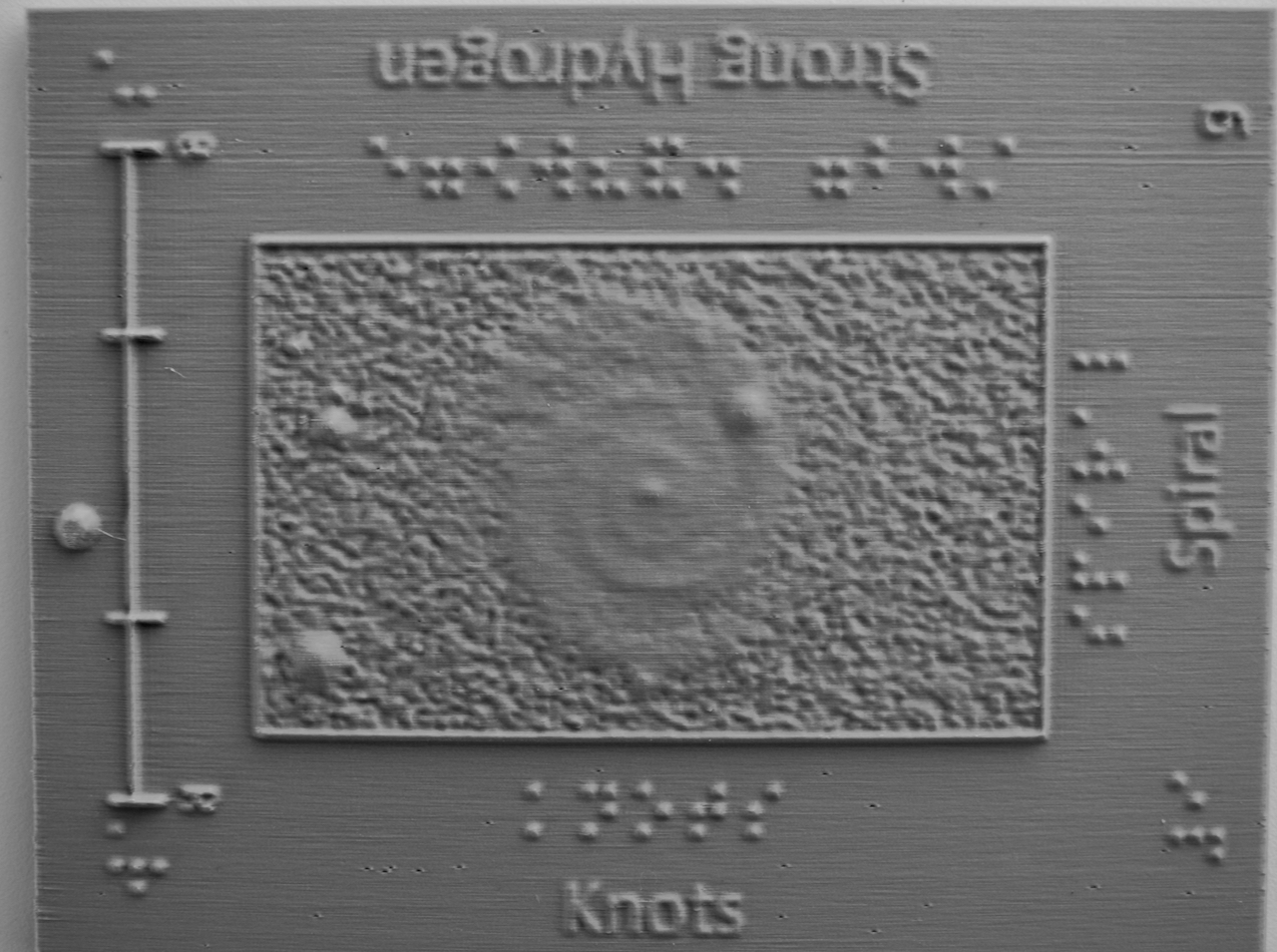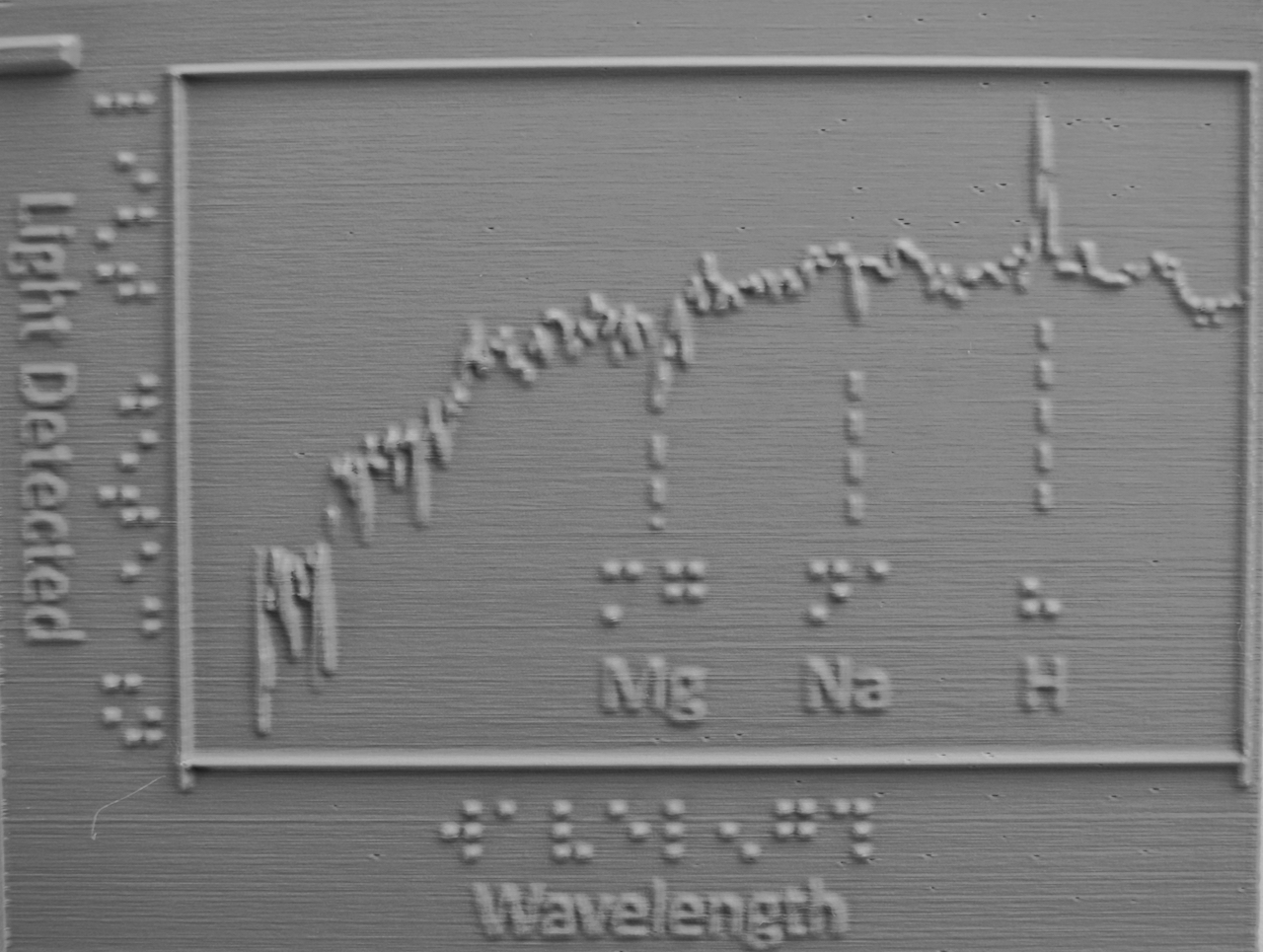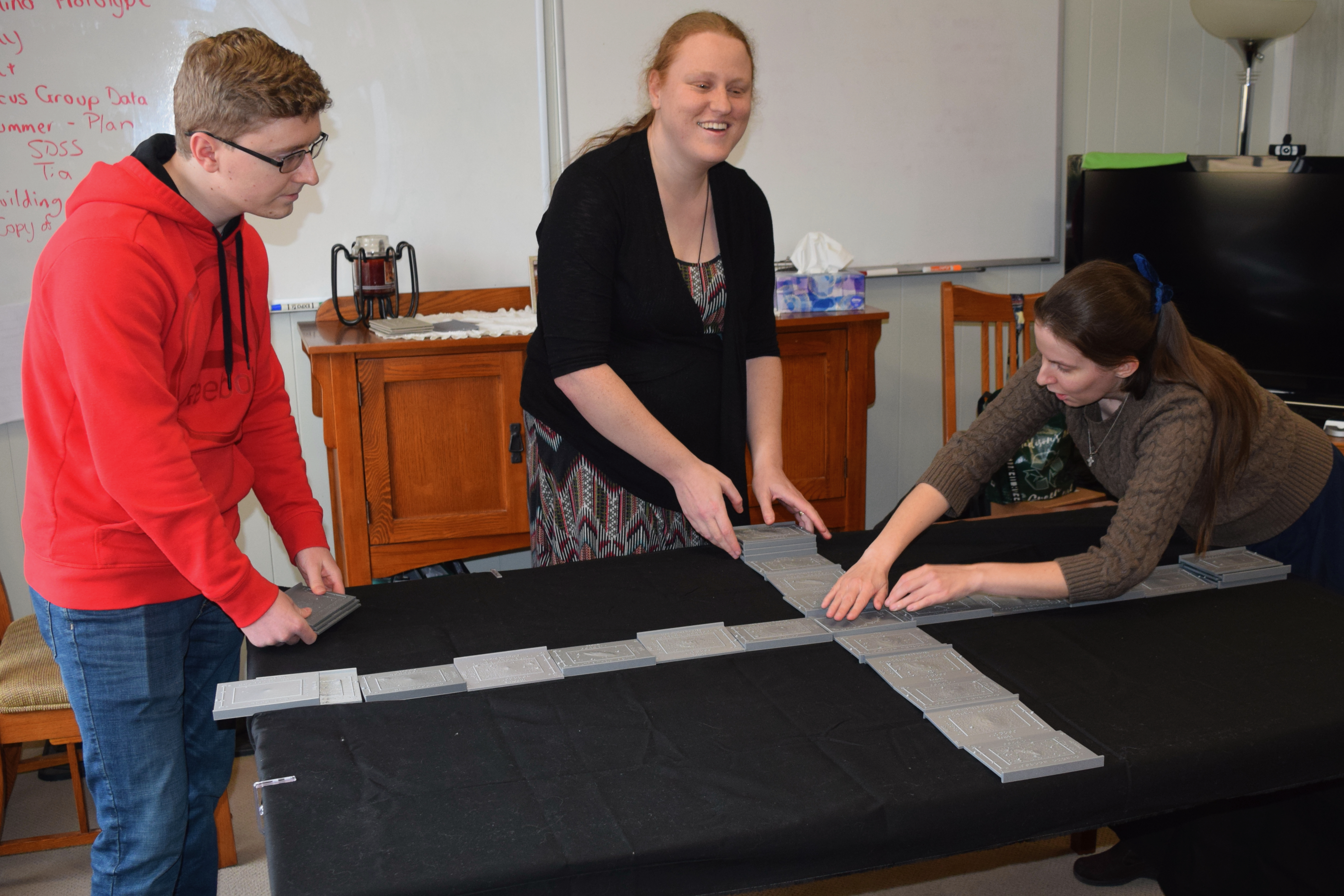Tactile Galaxy Cards: A New Accessible Hands-on Tool for Teaching
Kate Meredith GLAS Education
with Kristin Baker (University of Indiana), Katherine Corbett (GLAS Education), and Olivia Smithmier (GLAS Education)
Astronomy 101 Galaxy Morphology lecture is about to begin. You are handed a rectangular plastic card the size of a large coaster. You explore and quickly ignore the fine background texture resulting from the special matte-finish 3D print filament and focus on decoding the tactilely rich surface. Quickly. A random frenzy of bumps in a variety of heights and textures seem to be scattered without regard to the smooth, elegant swirl at the center. The busy tactile landscape ends abruptly at a ridge. ust outside this fence line, you discover … braille! You read “strong hydrogen” on the first side. You turn the card, “spiral.” Again. Now the word “bar.” The final turn presents a puzzle: the letter R, a line with three divisions, and finally, the letter B at the far right-hand end. A distinct bump marks a point along the line very near the B end of the line. The back of the card contains a line graph of light intensity versus wavelength with several features labeled with element symbols. The two sides must be related, but how? It is clear from the clinks and conversation around you that everyone has a card like yours. You lean to your neighbor and their words and central pattern are all different. Everyone starts trading and speculating. Then the lecture begins.


No matter the pedagogical approach you prefer, the tactile galaxy cards provide inquiry-based options for learning about galaxies, their structures, colors, and how those characteristics are reflected in their spectra. They are designed to be a hands-on invitation to explore further with the full power of the Sloan Digital Sky Survey (SDSS) database at the ready. Initial testing shows they can be used successfully to teach content related to galaxy structure and spectral features, or as individual cards as described above or in modified games of dominoes or Go Fish. For each feature detailed in the sections below, we provide a little bit of background information and insight for you to get to know this project better and possibly gain some inspiration for an accessible project of your own.
The Cards
The GLAS galaxy cards are inspired by a deck of 104 printed cards that were first encountered at an AAS meeting. The cards were beautiful and inspiring, but completely inaccessible. Three years since bringing them home to Wisconsin, six interns and half a dozen focus groups later, we have a product that is almost ready to share.
Design Notes:
- Once we assigned the cards the education purpose described above, we constrained the number of galaxies in the deck to half the original number (52) and explored printing options.
- The paper version was set aside in favor of exploring 3D printing, but feedback from educators of blind and visually impaired students requires that the printed version will be part of the final package.
- The choice of filament for 3D printing is critical for the experience of players. A matte filament in a light tan color immediately produced some positive noticeable differences. The filament must minimize the glare on the cards under fluorescent lights for sighted players. Matte finish filament also produces less harsh sounds when the cards bang together. First noticed by blind testers, this was quickly identified as essential by everyone.
- Each card is identified with a print and braille number so that instructors can use the resource we provided to access the original SDSS data for each galaxy.
The Central Galaxy
Each card features one low redshift SDSS galaxy from the original. To create the galaxy, we used the Blender plugin from Tactile Universe, a program specifically for making astronomy accessible to the blind and vision impaired community.
Design Notes:
- Galaxies were chosen to provide a representative sample of different galaxy shapes and features, with Galaxy Zoo designations of “spiral,” “elliptical,” “pencil,” and “irregular” used in relatively equal numbers.
- The galaxy is bounded by a raised line that is equal to the highest saturation level for all galaxy images.
Physical Features
On each of the four sides of the card there is one galaxy descriptor from four categories. The first side includes the most notable physical characteristics that occur in many different galaxies: “smooth,” “knots,” “dust lane,” and “bar.” Each galaxy has only one characteristic identified although many have numerous features. The characteristic listed on each card was chosen with eventual game play in mind.
Spectral Features
Opposite the physical feature on each card is a word that denotes a spectral feature. The descriptions used directly connect the galaxy on the front side to the spectrum on the back and describe an observable feature of the spectrum.
Design Notes:
- The spectral features are “4000 Angstrom Break,” “No Emission,” “Strong Hydrogen,” and “Strong Oxygen.” “Strong Hydrogen” refers to the Hα emission line, and “Strong Oxygen” refers to the [OIII] doublet emission lines.
- A galaxy can have multiple applicable spectral features, but we divided them up to allow more playing options.
- The spectral feature and physical features can appear on either of the long sides of the cards. This “feature flip flop” allows for easier game play.
Color
Although changes to the side of the card describing the color of the galaxy is lengthy and contains some lessons in accessible design, in the end the choice to 3D print the cards removed any temptation to utilize visual interpretation of color. Color for each galaxy is denoted by a point on a number line with red (R) on one end and blue (B) on the other.
Design Notes:
- The line is divided into 3 sections so that matches can be determined without a lengthy debate.
- We use u–r for the color index. While this choice skews the galaxies to red, it ensures that the color index is positive, making the cards easier to construct and explain.
The SDSS Spectrum Side of the Cards
The spectrum side of the card contains an orientation marker: a prominent raised line segment placed in the upper left position (standard in material for the blind), allowing the user to be confident that they are exploring the spectral features accurately. Significant time went into smoothing, rescaling, and choosing features to highlight. The below decisions were made in consultation with experts familiar with SDSS spectra, education consultants, and teachers of the visually impaired.
- Although we consolidated the number of scales in use on the y-axis, they are not all the same and the scales are not marked.
- The flux measurement is generalized to “Light Detected” on the y-axis.
- “Wavelength” is on the x-axis.
- More spectral line features are marked on the back than are noted on the front of the card to allow expanded use. The features are: 4000 Angstrom Break, Na, Mg, O[III], and Hα.
- Some features are labeled in print and braille, with the label connected to the feature on the continuum by a dashed line. Other features are detectable by exploring the continuum itself.
- We used a gaussian smoothing function in Python with a FWHM of 5, which decreased the resolution such that some spectral lines were lost, but allowed cleaner 3D printed spectra. Some spectra lost the Hα feature, but none of those galaxies were labeled as “no emission.”
A Word About Braille
Though the number of braille users nation-wide remains low, the statistics are clear: most blind people who are employed in STEM fields read braille. We thought it critical to include braille on our cards so as to expose blind students to actual data used in the field. The sooner students are exposed to and can work with data, the more likely they are to develop a fascination and enthusiasm for a career in STEM. Providing a pleasant feel while fitting the needed information on the card was a significant technical challenge. We tested each card with braille readers to ensure that the tactile images and braille made sense. Including blind and visually impaired people in the process helped us create a truly accessible product.

What’s Next for the Project?
With the card design at a stable point, instructional materials are being created. These will include: information about the design of the cards; background information about galaxy structure and spectra; 3D printing instructions and files; and suggestions for how to use them, including games such as Galaxy Dominoes and Go-Galaxy (Go Fish). If you would like to receive information about this project as it progresses, email [email protected].
GLAS Education would like to thank the National Federation of the Blind and the Paul M. Angell Family Foundation for their continued support of our efforts to develop accessible materials and programs.

